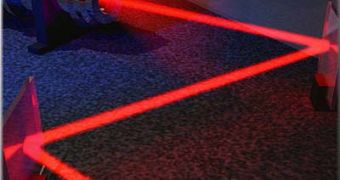Every material exposed to high-intensity light will degrade over time. White paper turns yellow, dyes bleach and fade, and molecules that fluoresce when struck by a laser - as the chemical in the present study does - stop fluorescing. Until recently, that degradation in response was thought to be irreversible.
Physicist Mark Kuzyk and colleagues at Washington State University conducted a study on a molecule that loses its ability to fluoresce when struck by a laser beam, and discovered that, if it's allowed to "sleep" in the dark, it will begin regaining its fluorescing ability within 30 minutes, and it will completely recover after 8 hours.
The "self-healing" property was discovered by the scientists in AF455, a dye compound that was designed to excel at two-photon absorption. That's a process in which the absorption of light energy from a laser causes a change in the molecule that can be harnessed for various purposes. Many molecules also glow, or fluoresce, during two-photon absorption, which allows researchers to monitor the process.
The observation was made during constant irradiation by the laser, with the most intense dose (4.5 microjoules per pulse), when within 200 minutes the response had dropped to about 60 percent of the starting level. The laser was then turned off and the sample allowed to 'rest' in the dark. After that, it was briefly irradiated at 30-minute intervals, to measure its fluorescent response. Just half an hour after being put in the dark, AF455 had already begun to recover. It continued to improve throughout the 8-hour dark period.
The material's ability to respond was lost more rapidly with the increased intensity of the laser. In all cases, regardless of the intensity of light used to exhaust the material, the recovery proceeded with the same time constant. That indicates that the mode of recovery does not depend on the severity or means of the decline, Kuzyk said.
So far, the self-healing property does not appear to be a general phenomenon of fluorescing materials. Partial recovery is known to occur in one other molecule, while full recovery has only been observed in AF455 and in DO11, another compound studied by Kuzyk's group.
"The fact that it is happening is very interesting, because it means that when you make devices out of this kind of material, as long as you let them rest once in a while, they appear to be able to work for much longer" than materials that lack the self-healing ability, he said.
Some of the most prominent applications of two-photon absorption are optical data storage and photolithography, a technique using lasers to assemble parts for microscopic motors and nano-sized robots. Two-photon absorption can also be a nuisance, causing degradation of lasers and optical switches that route signals around the Internet.

 14 DAY TRIAL //
14 DAY TRIAL //